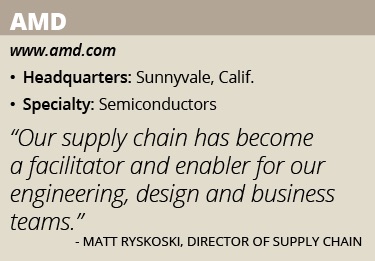AMD
AMD’s supply chain helps facilitate major changes to its business model that have taken place over the past few years. By Eric Slack
Millions of people around the world have felt the power and reaped the benefits of AMD’s innovations in high-performance computing, graphics and visualization technologies. Over the past 47 years, AMD has become known for designing and integrating technology that powers millions of intelligent devices.
Consumers, businesses and scientific research facilities around the world rely on AMD’s technology, which can be found in personal computers, game consoles, cloud servers and more. “Ours is a $4 billion company focused on building great products. And, as the industry continues to change, this means we must always explore ways to transform our operations to better meet the needs of our customers,” Director of Supply Chain Matt Ryskoski says.
 State of Change
State of Change
AMD has been implementing a strategy to transform its business in recent years. With the emergence of immersive computing experiences that seamlessly blend the physical and digital worlds, AMD has developed a high-performance roadmap focused on three significant markets: Gaming, Immersive Platforms and the Datacenter. In the past, the company’s business had been about 90 percent in PCs and GPUs. Today, it is split evenly to address this new era of compute. “At the same time we’ve focused our strategy and diversified our product portfolio, we’ve also moved to a fabless business model that involves working with many different partners,” Ryskoski says.
Included in this transformation is the recent formation of TF-AMD, a joint venture with Nantong Fujitsu-Microelectronics (NFME) that completes AMD’s transition to a fabless business model as NFME takes over controlling interest in AMD’s assembly-test, mark and pack operations in Penang, Malaysia and Suzhou, China. Throughout this process, AMD has been working to address and improve all business processes, systems and capabilities.
“The competitive landscape of the industry changed,” Ryskoski explains. “So we decided that a fabless manufacturing model was the right direction for our business. Our supply chain has become a facilitator and enabler for our engineering, design and business teams.”
The major shift for AMD has been a move away from managing operations and a move toward managing inventory and suppliers. The company has centralized its inventory management functions and focused more on enhancing its capabilities and leveraging industry standard processes and software solutions while increasing its focus on the customer.
“In 2015, we laid the foundation for the company by aligning processes across different business units and converging operations under a unified model,” Director of Supply Chain Renato Fragale says. “Now we can focus on opportunities such as ensuring we have the right material requirements planning (MRP) system and managing down inventory, leveraging it as an asset so we can have better customer relationships and increase on-time delivery to our customers.”
In fact, consistently meeting on-time delivery performance is one of AMD’s main priorities. The company now measures on-time delivery performance across all of its products to all customers to make sure it remains a key focus throughout the organization.
“Right now, customers may not yet see the full impact of everything we are doing – and that’s intentional,” Fragale says. “Despite the activity in the background as we strengthen our supply chain, our customers should only experience the benefits of these changes.”
A big part of AMD’s focus over the past several years has been on ensuring solid execution, and its customers are seeing the effects of this with increased consistency in production and delivery. Meanwhile, AMD is being more aggressive with supplier selection. Although the company still wants to build relationships with suppliers, it is not shying away from exploring new opportunities.
“We are constantly looking at what new technology is available and what suppliers can offer, and comparing our options against what we’re trying to achieve,” Fragale says.
That ability enables AMD to be more competitive. Since it can partner with suppliers anywhere in the world to be a part of its supply chain, the business has more options and reduces its risk as it brings new products to market.
Ongoing Journey
Now that it has shifted to this fabless model, AMD’s focus is on integrating and institutionalizing business process and system changes throughout the organization and improving inventory management, while also investigating possible changes to MRP and planning systems.
“We’ve done a lot of work already to get business processes aligned; we’ve engaged in training, collaboration and moving people around in the company to make sure we have the right skills in the right areas,” Ryskoski says. “We will bring in new people and tools as needed to fill gaps.”
As part of its ongoing efforts around improving inventory management and centralization, AMD now has more people from its supply chain team working with its sales organization to make sure it shifts inventory to where it is needed the most. And as it considers changes to systems such as its MRP system, it is looking at a number of potential third-party solutions.
“Historically, we’ve done those solutions in-house, but now we think it best to partner with third-party solution providers to help us with that implementation,” Ryskoski says. “We think that will be a good way to make sure we have the right tools to support our supply chain in a dynamic and competitive marketplace.”
“This has been a journey of transformation, and it is not about getting to a simple destination,” Fragale adds. “You can never afford to be idle in supply chain because systems and processes change over time. We know that we must be proactive with how we manage supply chain and have an ever-evolving road map.”